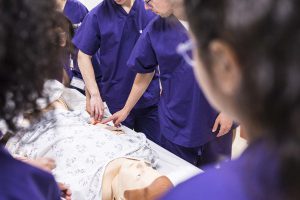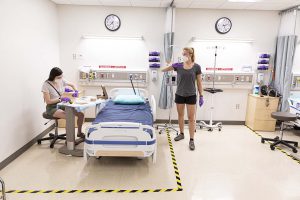When nursing students arrive for their first session at the Simulation Center, they sometimes find the manikins — fleshy, prone, mouths agape — intimidating.
Instructor Sarah Albaum, DNP (’20), on the other hand, is an enthusiastic fan.
“We have some incredible manikins that have very realistic capabilities,” she says. “Their heart and lungs sound, their pupils constrict and dilate, they have pulses.”

The manikins are part of a years-long renovation and expansion of the UW School of Nursing’s Simulation Center, funded by the State of Washington and donors like Evie Lynn.
Lynn, a member of the school’s advisory board, has long been involved in the healthcare field. With degrees in counseling psychology and marriage and family therapy, Lynn is now the board chairman of Careage, a family-owned business that constructs, manages and operates senior living facilities in Washington and California. Careage hires a substantial number of nurses, notes Lynn.
“We need good simulation centers,” says Lynn. “It’s very important for nurses to have a good education with actual hands-on procedures.”
Hands-on procedures — in a controlled practice environment — are precisely what the Simulation Center offers. Using state-of-the-art equipment and technology, undergraduate students learn critical skills, such as how to insert IVs, manage a central line and handle a Foley catheter, among others. Graduate students take on subjects such as biopsies, laceration repair and cyst removal.
All the students get the chance to practice, to make mistakes, to manage emergencies, to work as a team — and to sync up hands-on and classroom learning. It’s an enormously valuable learning experience that helps prepare nurses for treating real patients.
“We’re really developing students’ critical thinking skills,” says instructor Miki Sato, DNP (’20). “They bring in all they’ve learned about pathophysiology and medications, and then they figure out how all of it connects.”
In her turn, Albaum reflects on how the Simulation Center changes the students. For one, the undergrads are no longer leery of the manikins.
“By the time students get to their final, most intense simulation, you’ll see them hop on a manikin’s chest to deliver high-quality compression,” says Albaum. “They’re not afraid to jump in and deliver CPR. They’re not afraid to assume new roles.”

Capacity-building is a key part of the process at the Simulation Center.
“So much of nursing can only be learned at the bedside, and we’re doing our best to give our students the confidence and skills for a strong foundation,” adds Sato.
Lynn, who has met several students from the UW School of Nursing, is impressed by their innovation, their openness to new ideas and their qualifications. She knows that her gift is an investment in a precious resource: excellent nurses.
“The better the education,” says Lynn, “the better the nurse.”